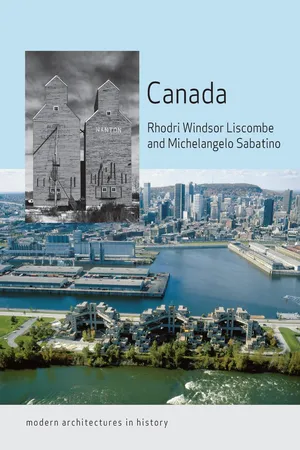![]()
References
chapter one Modernity in Canada, 1886–1914
1 W. Kaye Lamb, History of the Canadian Pacific Railway (New York, 1977); Pierre Berton, The National Dream: The Great Railway, 1871–1881 (Toronto, 1970); Pierre Berton, The Last Spike (Toronto, 1971); see also Harold Innis, A History of the Canadian Pacific Railway (London, 1923); For the other transcontinental systems, see Donald MacKay, The People’s Railway: A History of Canadian National (Vancouver, 1992); Leonard Frank, A Thousand Blunders: The Grand Trunk Pacific Railway and Northern British Columbia (Vancouver, 1996). In the U.S. the first transcontinental railroad from Iowa to California was completed in 1869, connecting with existing networks in the eastern states.
2 John Whalley, Canada’s Resource Industries (Toronto, 1986); Pierre Berton, The Great Klondike Goldrush: An Omnibus (Calgary, 2007); Donat le Bourdais, Metals and Men: The Story of Canadian Mining (Toronto, 1957).
3 Elsa Lam, ‘Wilderness Nation: The Myth of Nature in Canadian Architecture’, Journal of the Society for the Study of Architecture in Canada (JSSAC hereafter), XXXIII/2 (2008), pp. 11–20.
4 Thomas Flanagan, Riel and the Rebellion: 1885 Reconsidered (Toronto, 2000).
5 Neither, in company with all but Jean-Omer Marchand among Canadians of that generation, obtained the prestigious Diplome; see Isabelle Gournay, ‘Capper, Carlu, Cormier et les autres: Mapping out and Making Sense of the Beaux-Arts Diaspora in Canada’, paper read at the 41st Conference of the Society for the Study of Architecture in Canada, Annapolis Royal, NS, 2015.
6 Laurel S. MacDowell and Ian W. Radforth, eds, Canadian Working-class History (Toronto, 1992); Richard Allen, The Social Passion: Religion and Social Reform in Canada, 1914–28 (Toronto, 1973).
7 In 1914 Alice Charlotte Malhiot became the first woman to graduate from a School of Architecture (Edmonton) followed by Esther Marjorie Hill (Toronto) in 1920. See Annmarie Adams, ‘Marjorie’s Web: Canada’s First Woman Architect and Her Clients’, in Rethinking Professionalism, ed. Janice Anderson and Kristina Huneault (Montreal, 2012), pp. 380–99.
8 Harry Black, Canadian Scientists and Inventors (Markham, ON, 1997); Susan J. Douglas, Inventing American Broadcasting, 1899–1922 (Baltimore, MD, 1987); Charlotte Gray, Reluctant Genius: Alexander Graham Bell and the Passion for Invention (New York, 2006).
9 See www.steinerag.com.
10 Contract Record and Engineering Review (CR hereafter), XXVIII (1914), respectively pp. 1098–1100 (Royal Bank); p. 94 (Dominion Bank); pp. 1436–8 (Vancouver Club); pp. 873–4 (Foundations); pp. 1435–8 (Hennebique Ferro Concrete construction); p. 87 (Canada Cement mill); pp. 1182–8 (elevator construction); pp. 938–9 (Halifax Terminal). The Canadian blend of American and British idioms in high-rise architecture is examined by David Winterton in ‘Toronto’s Edwardian Skyscraper Row’, JSSAC, XL/2 (2015), pp. 77–99. Whereas Darling was born in Scarborough, ON, Pearson came from Chesterfield, England.
11 CR, XXVIII (28 January 1914), p. 94; for Turner’s comment see 12 February 1914, pp. 196–7.
12 CR, XXVIII (7 October 1914), pp. 1511–15.
13 Stephen Leacock, Canada: The Foundations of its Future (Montreal, 1941), p. 237.
14 Geoffrey Simmins, ‘Competing Visions for Redesigning the Canadian City: Architecture, Urban Planning and Landscape Architecture, 1893–1918’, in Artists, Architects and Artisans: Canadian Art, 1890–1918, ed. Charlie Hill (Ottawa, 2013), pp. 240–69. The first legislation was the New Brunswick Town Planning Act of 1915, for which see Walter Van Nus, The Planmakers and the City: Architects, Engineers, Surveyors and Urban Planning in Canada, 1890–1939 (Toronto, 1975); see also J. Barry Cullingworth, Urban and Regional Planning in Canada (London, 2015).
15 See www.raic.org; see also Kelly Crossman, Architecture in Transition: From Art to Practice, 1885–1906 (Kingston, ON, 1987).
16 A. L. Murray, ‘Frederick Law Olmsted and the Design of Mount Royal Park, Montreal’, Journal of the Society of Architectural Historians, XXVI/3 (1967), pp. 168–71. Jean Barman, Stanley Park’s Secret: The Forgotten Families of Whoi Whoi, Kanaka Ranch and Brockton Point (Madeira Park, BC, 2005). Sean Kheraj, Inventing Stanley Park: An Environmental History (Vancouver, 2013).
17 Barbara Chisholm, Castles of the North: Canada’s Grand Hotels (Toronto, 2001); Rhodri Windsor Liscombe, ‘Nationalism or Cultural Imperialism: The Château style in Canada’, Architectural History, XXXVI (1993), pp. 127–44.
18 Anthony Barrett and Rhodri Windsor Liscombe, Francis Rattenbury and British Columbia (Vancouver, 1983).
19 Respectively, France Vanlaethem and Isabelle Gournay, eds, Montréal Metropole, 1880–1930 (Montreal, 1998); John Leroux and Thaddeus Holownia, Saint Andrews Architecture, 1604–1966 (Kentville, NS, 2010), pp. 139–45.
20 See Isabelle Gournay and France Vanlaethem, ‘The Supreme Court Building’, in The Supreme Court of Canada and its Justices, 1875–2000 (Ottawa, 2000), pp. 195–212.
21 Harold Kalman and John Roaf, Exploring Ottawa: An Architectural Guide to the Nation’s Capital (Toronto, 1983); Marion Van de Wetering, An Ottawa Album (Toronto, 1997).
22 Rosalind Pepall, ed., The Architecture of Edward and W. S. Maxwell (Montreal, 1991); see also Simmins ‘Competing Visions’ 2013, pp. 259–62 and Bernard Flaman, Architecture of Saskatchewan: A Visual Journ...
